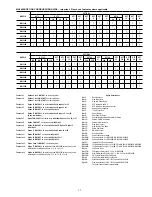
3
General
Stored Setups:
Stores front panel settings and nine additional front-panel setups in
a non-volatile RAM. A system menu allows saving and recalling of instrument setups.
Whenever the instrument is turned on, control settings come on at the same functions
and values existing when the instrument was turned off.
Memory Sequencing Input:
Accepts a TTL low-level signal to sequence through ten
stored setups. AUX I/O connector, rear panel.
Self-Test:
Instrument self-test is performed when Self-Test soft-key is selected. If an
error is detected, an error message is displayed in a window on the LCD identifying the
probable cause and remedy.
Secure Mode:
Disables all frequency and power level state displays. Stored setups
saved in secure mode remain secured when recalled. Mode selectable from a system
menu and via GPIB.
Parameter Entry:
Instrument-controlled parameters can be entered in three ways: key-
pad, rotary data knob, or the
∧
and
∨
touch pads of the cursor-control key. The keypad is
used to enter new parameter values; the rotary data knob and the cursor-control key are
used to edit existing parameter values. The
∧
and
∨
touch pads of the cursor-control key
move the cursor left and right one digit under the open parameter. The rotary data knob
or the
∧
and
∨
touch pads will increment or decrement the digit position over the cursor.
Controlled parameters are frequency, power level, sweep time, dwell time, and number
of steps. Keypad entries are terminated by pressing the appropriate soft key. Edits are
terminated by exiting the edit menu.
Reset:
Returns all instrument parameters to predefined default states or values.
Any pending GPIB I/O is aborted. Selectable from the system menu.
Master/Slave Operation:
Allows two output signals to be swept with a user-selected
frequency offset. One instrument controls the other via AUX I/O and SERIAL I/O connec-
tions. Requires a Master/Slave Interface Cable Set (Part No. ND36329).
User Level Flatness Correction:
Allows user to calibrate out path loss due to external
switching and cables via entered power table from a GPIB power meter or calculated
data. When user level correction is activated, entered power levels are delivered at the
point where calibration was performed. Supported power meters are Anritsu ML2437A,
ML2438A, and ML4803A and HP 437B, 438A, and 70100A. Five user tables are avail-
able with up to 801 points/table.
Warm Up Time:
From Standby: 30 minutes.
From Cold Start (0 deg C): 120 hours to achieve specified frequency stability with aging.
Instruments disconnected from AC line power for more than 72 hours require
30 days to return to specified frequency stability with aging.
Power:
85-264 Vac, 48-440 Hz, 250 VA maximum
Standby:
With ac line power connected, unit is placed in standby when front panel power
switch is released from the OPERATE position.
Weight:
18 kg maximum
Dimensions:
133 H x 429 W x 450 D mm
Warranty:
3 years from ship date
Remote Operation
All instrument functions, settings, and operating modes (except for power on/standby) are
controllable using commands sent from an external computer via the GPIB
(IEEE-488 interface bus).
GPIB Commands:
Native, SCPI
GPIB Address:
Selectable from a system menu
IEEE -488 Interface Function Subset:
Source Handshake:
SH1
Acceptor Handshake:
AH1
Talker:
T6
Listener:
L4
Service Request:
SR1
Remote/Local:
RL1
Parallel Poll:
PP1
Device Clear:
DC1
Device Trigger:
DT1
Controller Capability:
C0, C1, C2, C3, C28
Tri-State Driver:
E2
GPIB Status Annunciators:
When the instrument is operating in Remote, the GPIB
status annunciators (listed below) will appear in a window on the front panel LCD.
Remote:
Operating on the GPIB (all instrument front panel keys except for the SYSTEM
key and the RETURN TO LOCAL soft-key will be ignored).
LLO (Local Lockout):
Disables the RETURN TO LOCAL soft-key. Instrument can
be placed in local mode only via GPIB or by cycling line power.
Emulations:
The instrument responds to the published GPIB commands and responses
of the Anritsu Models 6600, 6700,and 6XX00-series signal sources. When emulating
another signal source, the instrument will be limited to the capabilities, mnemonics, and
parameter resolutions of the emulated instrument.
Environmental (MIL-PRF-28800F, class 3)
Storage Temperature Range:
–40 to +75 °C
Operating Temperature Range:
0 to +50 °C
Relative Humidity:
5% to 95% at 40 °C
Altitude:
4,600 meters, 43.9 cm Hg
EMI:
Meets the emission and immunity requirements of
EN61326: 1998
EN55011: 1991/CISPR-11:1990 Group 1 Class A
EN61000-4-2: 1995 – 4 kV CD, 8 kV AD
EN61000-4-3: 1997 – 3 V/m
EN61000-4-4: 1995 – 0.5 kV SL, 1 kV PL
EN61000-4-5: 1995 – 1 kV – 2 kV L-E
EN61000-4-6: 1996
EN61000-4-11: 1994
Vibration:
Random, 5-500 Hz, 0.015-0.0039g
2
/Hz PSD
Sinusoidal, 5-55 Hz, 0.33 mm displacement
Safety Directive:
EN 61010-1: 1993 + A1: 92 + A2: 95




































